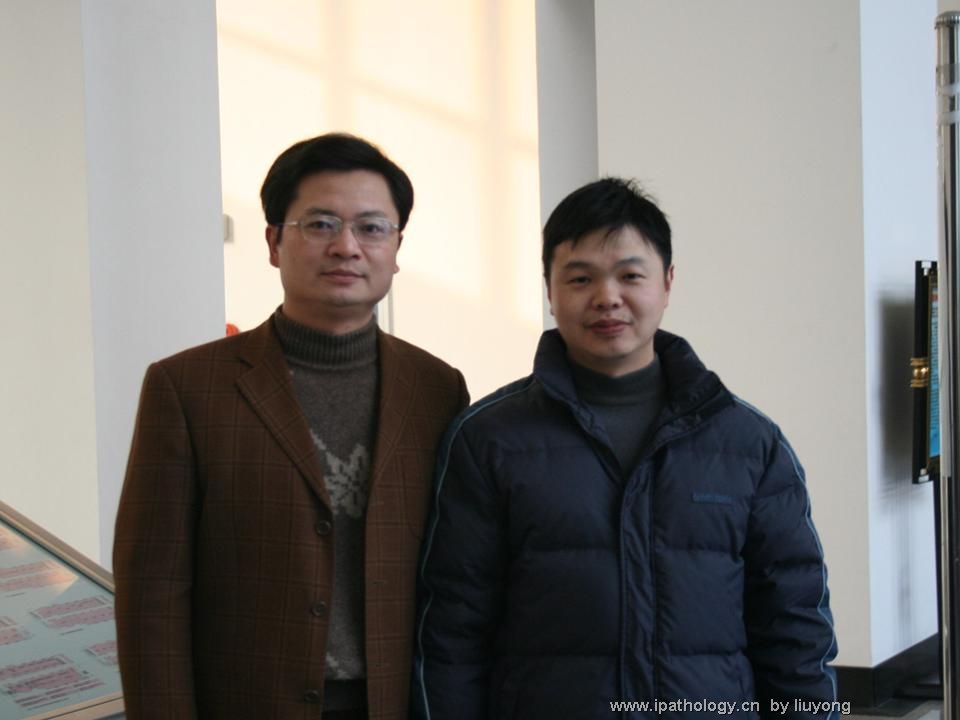| 图片: | |
|---|---|
| 名称: | |
| 描述: | |
- (推荐)Askin 瘤的起源及本质
Askin 瘤的起源及本质
范钦和 南京医科大学一附院 210029
摘要 目的:探讨Askin 瘤的本质,起源。方法:以临床—病理观察,免疫组织化学,电子显微镜技术和细胞遗传技术对22例Askin瘤进行研究。结果:显示瘤细胞免疫组化为MIC2(CD99),NSE、cgA 阳性;电镜见神经分泌颗粒;细胞遗传分析示特异性基因遗传异位,即t(11;22)(q24;q12)。这些特点与恶性原始神经外胚叶肿瘤(PNET)相同。结论:我们认为Askin瘤实际上是PNET/尤文氏肉瘤家族的一员,只是发生部位较特殊,预后不良。应与其它小圆细胞肉瘤如淋巴瘤,胚胎型横纹肌肉瘤,横纹肌样瘤,圆细胞脂肪肉瘤,结缔组织生成性小圆细胞肿瘤相鉴别。
关键词 Askin瘤;PNET/尤文氏肉瘤;免疫组化;电子显微镜;
细胞遗传分型
中国图书分类号 R:738.6
作者单位:南京医科大学第一附属医院理科210029
作者简介:范钦和,男,48岁,硕士研究生毕业,主任医师,教授,病理科主任。国际外科病理学杂志编委,澳太地区软组织肿瘤会诊中心委员,江苏省病理学会和肿瘤学会主任委员。研究方向:软组织肿瘤
The origination and reality of Askin tumor
1Fan Qinhe, 2Philip W. Allen, 1Xu Tianrong et al
(1Department of Pathology, The First Affiliated Hospital of Nanjing Medical University, Nanjing 210029)
ABSTRACT Purpose To study the origination and reality of Askin tumor. Method Twenty-two cases of these lesions have been studied by clinical-pathologic observation, immunohistochemistry, electron-microscopy, and cytogenics in this paper. Results The results revealed the positiveness of MIC2(CD99), NSE, Chromogranin A(CgA) by immunohistochemistry, neurosecretory granules by electron-microscopy, and the specific genotypic translocation of t(11:22)(q24:q12) by cytogenetic analysis, which were identical to the malignant primitive neuroectodermal tumor (PNET). Conclusion We conclude that this lesion is actually the one member of the PNET/Ewing’s sarcoma family, except the special location. Differential diagnoses between this tumor and other small round cell sarcoma such as lymphoma, embryonal rhabdomyosarcoma, rhabdoid tumor, round cell liposarcoma and desmoplastic small round cell tumor were also discussed in this article.
KEY WORDS Askin tumor; PNET/Ewing’s sarcoma; immunohistochemistry; electron-microscopy; Cytogenetic analysis
1979年,Askin等人首先描述了20例“儿童和青少年胸肺部恶性小细胞肿瘤”,认为其有别於尤文氏肉瘤,神经母细胞瘤,神经上皮瘤,胚胎型横纹肌肉瘤,淋巴瘤等小细胞性肉瘤,是一种起源末定的新的独立类型(1),其后,不少作者也报告了各自的类似发现,并称之为Askin瘤(2、3)。
Askin瘤可见於胸壁软组织,肋骨骨膜、肺。瘤组织主要由大小较一致的小圆细胞所组成,排列成片块状或形成假小叶。肿瘤易复发和转移,为高度恶性、临床预后差。
随着免疫组化、电子显微镜及分子生物学技术的发展,人们对Askin 瘤有了深入的认识。本文作者就自己所收集的确22例Askin 瘤进行临床--病理、免疫组化、电镜状和细胞遗传学研究,以进一步探讨其起源和本质。
1 材料及方法
22例Askin瘤来自江苏省人民医院(南京医科大学一附院)病理科和澳太地区软组织肿瘤会诊中心1985-1998共14年间的常规活检病例和会诊病例。原诊时名称为Askin 瘤和胸(肺)部恶性小园细胞肿瘤。
所有病例均以福尔马林固定,常规处理。复习了所有H.E切片,初步确认诊断。其中18例做了免疫组织化学,第一抗体有MIC2(CD99),神经元特异性烯醇化酶(NSE),突触素(Synaptophysin),嗜铬蛋白A(Chromogranin A), S-100蛋白,胶质原纤维酸性蛋白(GFAP),波形纤维蛋白(Vimentin),角蛋白(Keratin),白细胞共同抗原(LCA)。采取ABC、PAP法。试剂分别来自DAKO公司,Vector公司和Sigma公司。
5例做了电子显微镜观察,取新鲜肿瘤组织标本固定於戌二醛,按电镜标本制作程序制作成铜网后上透射电子显微镜观察。
4例作了细胞遗传学检查,均采取新鲜肿瘤组织标本由细胞遗传学实验室作染色体核型分析。
2 临床资料
患者以儿童和青少年为主,年龄范围1-23岁,平均年龄13岁。男:女为12:10,其中白人10例,亚洲人12例。病人主要症状和体征依次为胸壁肿块,胸痛,呼吸困难,发热和胸水。肿瘤发生部位依次为胸壁软组织(常累及肋骨)18例;壁层和脏层胸膜3例;外周肺1例。
X光主要表现为胸壁肿块,肺肿块,胸水。
所有病例均经切除活检,其中5例术中先行冷冻病理诊断。诊断建立后手术切除全部肉眼可见肿瘤,术后辅以放疗和化疗。
12例病人获随访结果,10例病人在5年内死亡(83%)。存活期由3个月至59个月左右不等,平均7个月,5年存活率仅仅13%。病人死於局部复发和转移,转移部位依次为骨(6例、50%),肺(4例、33%),胸膜(1、8%),肝(1例、8%)。
3 病理变化
眼观:为圆或椭圆形结节,直径3-15cm,平均6.5cm。肿瘤呈多结节、分叶状、境界尚清楚,但无包膜。切面灰白色或鱼肉状,常见出血及坏死灶。
镜检:瘤细胞为小圆形,短梭形。胞浆较少,环绕於核周围。瘤细胞大小较一致。排列成片块状,巢状或小叶状,其间由纤维血管形成纤细的网状结构(图1)。瘤组织内常见坏死形成,其间存活的瘤细胞形成匐行带。
6例瘤组织见“线状构型”(Filigree Pattern),即瘤细胞排列成细束带状,其间由纤维血管间隔(图2)。“线状构型”中有4例获随访结果 ,存活期3个月至28个月,平均4个月,低於无“线状构型”的病人。
免疫组化结果: 部分病例做了免疫组织化学,阳性者胞浆见棕色颗粒(DAB显色)或红色颗粒(AEC显色)。阳性结果为:MIC2(CD99),13/15(86%);NSE,9/15(60%);CgA,6/10(60%);S-100蛋白,1/10(10%);GFAP,2/10,(20%);突触素,0/6;白细胞共同抗原,0/20(图3)。
电镜观察:3例做了电子显微镜检查,示瘤细胞为小圆形细胞,胞浆突起,相邻胞膜见桥粒样结构。其中两例见神经分泌颗粒,神经丝和神经管结构(图4)。
4 细胞遗传学检测
4例经细胞遗传学检查,染色体排列均示特异性核型异常,即染色体t(11;22)(q24;q12)。
5 讨论
1979年,Askin等人首次报告了这种发生於儿童和青少年的胸肺部恶性小圆细胞肿瘤。认为其属一类高度恶性的肿瘤,有特殊定的发生部位,有别於其它小圆细胞肿瘤,是一类起源未定的恶性肿瘤(1)。随后一些作者也陆续报告了他们的发现,同意其为一新类型的肿瘤,并称之为Askin瘤(2、3),这个名称逐步为大家所接受。
Askin瘤与1921年问世,至今已有半个多世纪的尤文肉瘤(Ewing’s sarcoma),以及近年提出的恶性原始神经外胚叶肿瘤(Primitive Neuroectodermal Tumor, PNET)之间究竟如何区别,一直是个难题且为大家所关注。本研究的观察发现,本组22例Askin瘤的临床资料和病理变化与PNET/尤文氏肉瘤几乎不能区别。只是本病位於胸肺部;而尤文氏肉瘤主要位於骨,但亦有发生於软组织;PNET以软组织为主,亦可见於其它部位。
免疫组化示NSE、MIC2(CD99)和CgA阳性;电镜中见到神经分泌颗粒均示本病为神经嵴起源,与PNET/尤文肉瘤相似。细胞遗传学所示的核型异常,t(11、22)(q24、q12)异位,更与PNET/尤文氏肉瘤同出一辙。显示本病与PNET/尤文氏肉瘤是同一起源,或属同一家族。因为这种染色体异位是特征性的,与其它肿瘤不同,这种特异性是可重复的。这与最近的文献报告十分相似(4~11)。本病的临床生物学行为、治疗、预后也与PNET/尤文氏肉瘤一样。但由於本病系Askin首先提出,且有特定部位。故Askin瘤的名称仍有其历史意义,此名称似仍可续用。只是其本质起源已经明了,分类时应属PNET类,而非起源未明。
本组病例中所见到的线状构型(Filigree pattern),本质上是肿瘤浸润性生长的一种方式,浸润性生长越明显,其预后也越坏。Filigree pattern也见於尤文氏肉瘤和PNET(8、11)。
Askin瘤应和其它恶性小圆细胞肿瘤如恶性淋巴瘤、胚胎型横纹肌肉瘤、圆细胞脂肪肉瘤、恶性横纹肌样瘤、促结缔组织生成性小圆细胞肿瘤区别。恶性淋巴瘤、胚胎型横纹肌肉瘤皆有明显的标记物如LCA,T和B的标记物;肌红蛋白,结蛋白细丝作为的效鉴别诊断。圆细胞脂肉瘤无有效标记与PNET类区别,但圆细胞脂肪肉瘤有脂肪分化的特征(脂母细胞)可觅。恶性横纹肌样瘤原认为起源不明,近来研究结果示其并不一定是一个独特的类型,而是某些分化差的小圆细胞肿瘤的一种表现形式。其组织学特点为核仁特别明显,胞浆内有包涵体样物质。免疫标记多样性,无特定的标记可作为诊断依据。细胞遗传染色体分型也与Askin-PNET-Ewing家族的不同。促结缔组织生成性小圆细胞肿瘤是1989年提出新型起源未定的高度恶性肿瘤(12),该肿瘤主要见於腹膜、偶见於胸膜。其特点为小圆细胞形成多巢状的结节,背景见显著的结缔组织增生,整个肿瘤构型似类癌样。其免疫组织化学、电镜均示多样性和未分化性,细胞遗传染色体异位为t(11、12)(P13、q12),亦与Askin瘤不同。
参考文献
1 Askin FB, Rosai J, Sibley PK et al. Malignant small cell tumor of the
thoracopulmonary region in childhood: A distinctive clinicopathologic entity of
uncertain histiocytosis. Cancer, 1979;43:2438
2 Linnolia RI, Tsokos M, Triche TJ et al. Evidence for neural origin and PAS-
positive variants of the malignant small cell tumor of thoracopulmonary region (“Askin tumor”). Am J Surg Pathol, 1986;10:124
3 Gonzalez-Crussi F, Wolfson SL, Misugi K et al. Peripheral neuroectodermal tumors
of the chest wall in childhood. Cancer, 1984;54:2519
4 Contesso G, Llombart-bosch A, Terrier P et al. Does malignant small round cell
tumor of the thoracopulmonary region (Askin tumor) constitute a clinicopathologic
entity? An analysis of 30 cases with immunohistochemical and electron-microscopic
support Treated at the Institute Gustave Toussy. Cancer, 1992;69:1012
5 Ushigome S, Shimoda T, Takaki K et al. Immunocytochemical and ultrastructural
studies of the histogenesis of Ewing’s sarcoma and putatively related tumors.
Cancer, 1989;64:52
6 Llombart-bosch A, Contesso G, Peydro-Olaya A. Histology, immunocytochemistry, and
electron microscopy of small round cell tumors of bone.
Seminars in Diagno Pathol, 1996;13:153
7 Noguera R. Cytogenetics and tissue cultures of small round cell tumor of bone and
soft tissue. Seminars in Diagno Pathol, 1996;13:171
8 D’Amore ESG, Ninfo V. Soft tissue small round cell tumors: Morphological
parameters. Seminars in Diagno Pathol, 1996;13:184
9 Meis-Kindblom JM, Stenman G, Kindblom LG. Differential diagnosis of small round
cell tumors. Seminars in Diagno Pathol, 1996;13:213
10 Lopez-Terra D. Molecular genetics of small round cell tumors.
Seminars in Diagno Pathol, 1996;13:242
11 Terrier P, Llombart-bosch A, Contesso G. Small round blue cell tumors in bone:
Prognostic factors correlated to Ewing’s sarcoma and neuroectodermal tumors.
Seminars in Diagno Pathol, 1996;13:250
12 Leuschner I, Radig K, Harms D. Desmoplastic small cell tumor.
Seminars in diagno pathol, 1996;13:204
标签:
-
本帖最后由 于 2006-11-06 23:26:00 编辑
×参考诊断
-
本帖最后由 于 2006-11-19 20:31:00 编辑
2005年(Carvajal and Meyers 2005)
Carvajal, R. and P. Meyers (2005). "Ewing's sarcoma and primitive neuroectodermal family of tumors." Hematology-Oncology Clinics of North America 19(3): 501-+.
Ewing's sarcoma (ES) initially was believed to be of perivascular endothelial origin. The Ewing's sarcoma family of tumors (EFT) includes ES of bone (ESB), extraosseous ES (EES), peripheral primitive neuroectodermal tumor of bone (pPNET), and malignant small-cell tumor of the thoracopulmonary region, or Askin's tumor, all of which are now known to be neoplasms of neuroectodermal origin. The degree of neuronal differentiation has been used for histopathologic subclassification of the EFT as classical ES (ESB or EES), which is characterized by minimal evidence of neural differentiation, and pPNET, which displays evidence of neural differentiation by standard microscopy, electron microscopy, or immunohistochemistry. Because the behavior, prognosis, and treatment appear to be similar for all subsets of EFT, this histopathologic subclassification may not be clinically significant, though some debate remains whether neural differentiation predicts for inferior outcome.
Folpe, A. L., J. R. Goldblum, et al. (2005). "Morphologic and immunophenotypic diversity in Ewing family tumors - A study of 66 genetically confirmed cases." American Journal of Surgical Pathology 29(8): 1025-1033.
More than 85% of Ewing sarcoma/primitive neuroectodermal tumor (ES/PNET), or "Ewing family of tumors" (EFTs), have the translocation, t (11;22) (q24;q12), with others having variant translocations. Identification of these by cytogenetic and/or molecular genetic techniques is specific for EFT and is increasingly recognized as the "gold standard" for diagnosis. However, these techniques are not universally available. We therefore studied a large group of genetically confirmed EFTs to more completely understand the morphologic and immunophenotypic spectrum of this rare sarcoma. Sixty-six cytogenetically, FISH or RT-PCR proven-EFTs were retrieved. In 56 cases, immunohistochemistry (IHC) was performed for pancytokeratins (PanCK), high molecular weight cytokeratins (HMWCK), desmin (DES), CD99, CD117, and FLI1 protein using heat-induced epitope retrieval and the Dako Envision system. The cases arose chiefly in children and young adults (median 18 years; range, 3-65 years) of both sexes (male, 32; female, 3 1; unknown, 3) in a variety of bone (N = 39) and soft tissue (N = 27) sites. Histologically, 46 cases (73%) showed only typical features of ES, 9 cases (16%) showed features of PNET, 3 cases (5%) showed "adamantinoma-like" features, 3 cases (5%) corresponded to "atypical Ewing sarcoma," 3 cases (5%) showed principally intersecting fascicles of spindled cells, and 2 cases had abundant hyalinized matrix. IHC results were as follows: PanCK (18 of 56, 32%), HMWCK (3 of 55, 5%), DES (1 of 56, 2%), CD99 (52 of 52, 100%), CD117 (13 of 54, 24%), and FLI1 (44 of 47, 94%). HMWCK was expressed only in "adamantinoma-like" EFTs, none of which expressed DES. In conclusion, most, but not all, EFTs can be accurately diagnosed using time-honored morphologic criteria and ancillary immunohistochemistry. However, genetic confirmation remains essential for the diagnosis of unusual morphologic variants of EFT, including "adamantinoma-like," spindled, sclerosing, and clear celt/anaplastic variants. Therefore, to exclude or confirm the diagnosis of Ewing's sarcoma in round cell sarcomas having a variety of patterns but not specifically conforming to a tumor of known lineage (eg, rhabdomyosarcoma), cytogenetics, and/or molecular analysis is required.到此,文献回顾完毕

- 达亦不足贵,穷亦不足悲
2001年who,将三者合并,变成了EWS/pnet。具体内容参阅WHO(2001)分类
Soft tissue tumor(第三版)也作了同样的归类。好像也是2001年出版的
2003年的研究(Burchill 2003)
Burchill, S. A. (2003). "Ewing's sarcoma: diagnostic, and therapeutic implications of molecular abnormalities." Journal of Clinical Pathology 56(2): 96-102.
The identification of the non-random chromosome rearrangements between the EWS gene on chromosome 22q12 and members of the ETS gene family in Ewing's sarcoma, peripheral primitive neuroectodermal tumour, Askin tumour, and neuroepithelioma has been a key advance in understanding their common histogenesis and defining the Ewing's sarcoma family of tumours (ESFT). In addition to improvements in diagnosis and potentially the stratification of patients for risk, biological investigations of these gene fusions may define targets for much needed therapeutic strategies to eliminate minimal residual disease or metastatic disease. Insight into their relation with other oncogenic events in ESFT will advance risk group analysis and ultimately may improve clinical management and survival for patients with this disease.
Yoshino, N., T. Kojima, et al. (2003). "Diagnostic significance and clinical applications of chimeric genes in Ewing's sarcoma." Biological & Pharmaceutical Bulletin 26(5): 585-588.
Ewing's sarcoma (ES) is one of the most malignant bone and soft tissue tumors in childhood. Morphologically, ES belongs to the small round cell tumors (SRCT). ES, peripheral primitive neuroectodermal tumor (PNET), and Askin's tumor are classified as ES family tumors (ESFT) because they share a common chromosomal translocation. The EWS-FLI1 chimeric gene is generated by t (11; 22). Other reciprocal translocations resulting in formation of chimeric genes between EWS and ETS family genes (ERG, ETV1, E1AF, and FEV) are t (21; 22), t (7; 22), t (17; 22), and t (2; 22), respectively. Although it is generally difficult to distinguish ES from SRCT, we could easily and quickly distinguish ES from other SRCT by using reverse transcription polymerase chain reaction (RTPCR). We looked for specific chimeric genes in 23 tumor samples, including three ES clinical samples. We detected five chimeric genes in the three ES samples. Three chimeric genes, all EWS-FLI1, were detected in one ES sample. Different chimeric genes, EWS-ERG and EWS-ETV1, were detected in the other two ES samples. Moreover, because we could not detect specific chimeric genes in samples from non-ESFT, it may be possible to use this technique to diagnose ESFT and to detect tumor cell contamination before hematopoietic stem cell transplantation.

- 达亦不足贵,穷亦不足悲
2000年的综述(de Alava and Gerald 2000)
de Alava, E. and W. L. Gerald (2000). "Molecular biology of the Ewing's sarcoma/primitive neuroectodermal tumor family." Journal of Clinical Oncology 18(1): 204-213.
Ewing's sarcoma (ES) and primitive neuroectodermal tumor (PNET) are members of a tumor family consistently associated with chromosomal translocation and functional fusion of the EWS gene to any of several structurally related transcription factor genes. Similar gene fusion events occur in other mesenchymal and hematopoietic tumors and are tumor-specific. The resulting novel transcription factor-like chimeric proteins are believed to contribute to tumor biology by aberrant regulation of gene expression altering critical controls of cell proliferation and differentiation. These tumor-specific molecular rearrangements are useful for primary diagnosis, may provide prognostic information, and present potential therapeutic targets. The recent advances in our understanding of the molecular biology of ES and PNET represent a paradigm for the application of the basic biology of neoplasia to clinical management of patients. (C) 2000 by American Society of Clinical Oncology.2001年的综述(de Alava and Pardo 2001)
de Alava, E. and J. Pardo (2001). "Ewing tumor: Tumor biology and clinical applications." International Journal of Surgical Pathology 9(1): 7-17.
The Ewing tumor family includes classical Ewing's sarcoma of bone and soft tissues, peripheral primitive neuroectodermal tumors (pPNET), Askin tumor, and other less frequent variants. This group of tumors is defined hy the consistent presence of chromosomal translocations resulting in gene fusions between EWS gene and a member of the ETS family of transcription factors, mainly FLI1 and ERG. Analogous fusions are seen in other solid developmental tumors, like desmoplastic small round cell tumor. These fusions, which are consistently present and tumor-specific, control transcription of several target genes, largely unknown but critical to cell proliferation and differentiation. Therefore. gene fusions are useful to diagnose and classify small round cell tumors, have prognostic significance, are probably useful to detect micrometastasis and monitor minimal residual disease, and are potential therapeutic targets. Secondary molecular alterations, which include mutations of cell cycle regulatory genes, are not tumor-specific but are related to progression and may have prognostic value. The Ewing rumor family represents a paradigm of the application of the knowledge of biology of neoplasia to the clinical management of patients.

- 达亦不足贵,穷亦不足悲






























